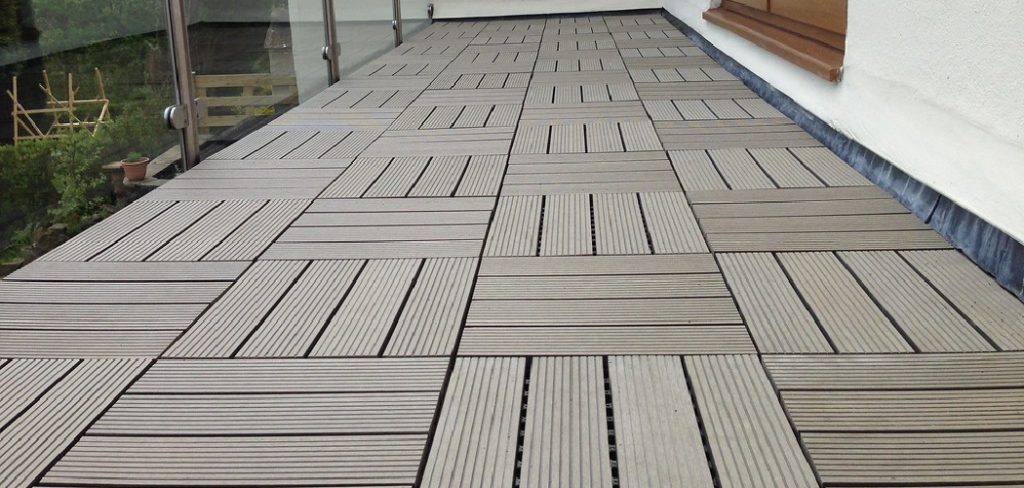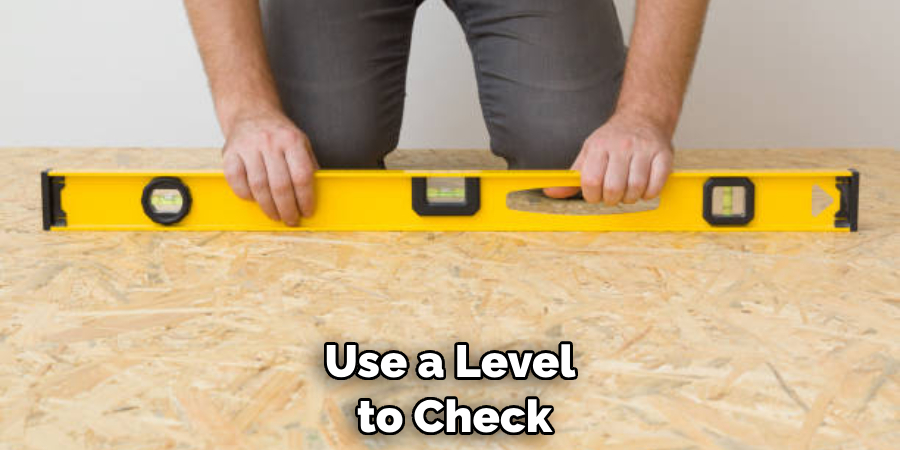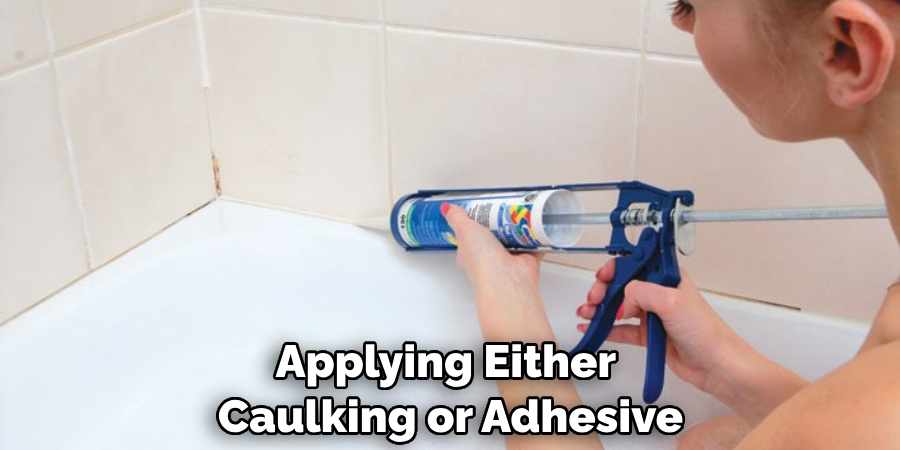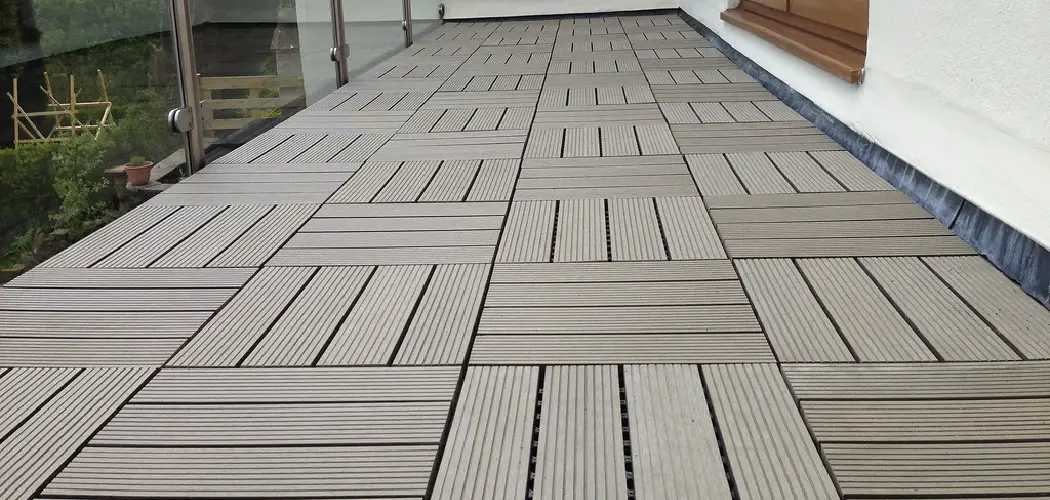Are you looking for an easy and affordable way to transform the look of your outdoor space? Deck tiles are a simple solution that can quickly and effectively cover up an unsightly surface or add style and pizzazz to your existing deck.

Not only are these tiles versatile, durable and low-maintenance, but they also come in a variety of colors, textures and designs to fit any outdoor aesthetic or taste. In this post on how to use deck tiles, we’ll walk you through everything you need to know about using deck tiles – from the different types available all the way through installation tips!
Needed Materials
Given below are the materials needed to install deck tiles:
- Deck Tiles
- Cordless Drill
- Phillips or Torx Bits
- Level
- Masonry Screws
- Rubber Mallet (Optional)
11 Step-by-step Guidelines on How to Use Deck Tiles
Step 1: Select the Right Type of Deck Tile
The type of deck tile you choose will depend on factors like your desired look, budget and climate. For example, porcelain deck tiles are best suited for outdoor spaces in cooler climates, while wood-look porcelain tiles tend to work better in warmer areas.
It’s important to also consider the overall weight of the tile, as heavier tiles may require additional support. This is especially important with elevated decks or roofs. If you’re not sure which tile is right for your project, consult with a contractor or decking professional.
Step 2: Measure and Mark the Area
Once you decide on the type of tile you want to use, measure the area where you plan to install it. Use a tape measure or ruler and mark on the ground where each tile will go. This way, you won’t have any surprises when it comes time to lay them down.
It’s a good idea to give yourself at least an inch of wiggle room on each side, too. If you’re using a patterned tile, you may want to draw out the pattern on the ground before you begin. Although this is optional, it can help you achieve a more cohesive look.
Step 3: Start from the Edge of the Space
Once your layout is mapped out and marked, start laying tiles from one corner or edge of your space. This ensures that each row is even and rotated correctly with respect to the next one. If you’re creating a pattern, make sure to line up the next row with the same orientation as your first. If you’re not sure, double-check with the manufacturer for installation instructions.
It’s also important to note that the rows should be staggered for better stability. This means that the upper end of one tile should effectively be covered by the bottom end of an adjacent tile.
Step 4: Use a Level
To ensure your tiles are properly leveled, use a level to check each tile before and after it’s installed. This will help you avoid any dips or bulges in your deck tile flooring. If your surface is uneven, you may need to use a rubber mallet or other tool to ensure the tiles are flush with each other.

But be careful not to hammer too hard or you could damage the tiles. It Is also important to note that if your deck is elevated, you will need additional support for the tiles.
Step 5: Pre-drill for Masonry Screws
If you’re using masonry screws to secure the tiles, pre-drill holes into each corner of the tiles with an appropriate sized drill bit. This will help make sure all the screws fit properly during installation.
It also prevents the tiles from cracking or splitting during installation. Buying a cordless drill with Phillips or Torx bits will come in handy for this step. It’s especially helpful when installing hardwood tiles, as they can be more difficult to drill into.
Step 6: Secure Tiles with Masonry Screws
Using masonry screws, secure the tiles to the surface they’ll be covering by drilling them into the pre-drilled holes. Be sure to use enough screws so that each tile is firmly attached and won’t move or shift when being walked on.

It is also important to make sure the screws are not too long and that they don’t protrude from the surface of the tile. This could cause injuries if someone trips over them. If you’re using a rubber mallet, you can use it to tap the tiles into place.
Step 7: Use a Rubber Mallet (Optional)
To make sure each tile has been properly secured, you can use a rubber mallet to tap down any tiles that may not be flush with the surface. This will help ensure an even finish for your deck tile flooring. This step is optional, but it can help to ensure that your tiles stay level and secure over time.
If you’re working with a patterned tile, make sure to line up the pattern before tapping with the mallet. It can also be helpful to practice on a spare piece of tile before working with the main installation.
Step 8: Apply Caulk or Adhesive (Optional)
If you want an extra secure hold, consider applying either caulking or adhesive between the deck tiles and the surface they are covering. This will create an additional barrier of protection against the shifting and displacement of tiles. It also helps to prevent water from seeping through the gaps between tiles and into the underlying surface. Be sure to read the instructions on your product carefully before applying any adhesive or caulk.

Step 9: Check the Layout
Once all your tiles are in place, double check to make sure they’re aligned correctly and that there aren’t any gaps or uneven areas. You can use a level for this if needed. If you notice any problems, now is the time to fix them. It’s much easier to do this before you start grouting or applying sealant.
This is especially true if you’re working with a patterned tile. If everything looks good, you can move on to the next step. However, if you find any issues, it’s best to go back and fix them before moving on.
Step 10: Seal the Deck Tiles (Optional)
If desired, you can seal the deck tiles to help protect them from weathering and other damage. This is generally done with a polyurethane sealant or specialized deck tile sealer, but always read product labels carefully before applying anything to your tiles.
It’s important to make sure the sealant or sealer is appropriate for the type of tile you’re using. After the sealant has been applied, let it dry completely before using the deck. It’s also a good idea to re-apply sealant every few years to help keep the tiles in good condition.
Step 11: Enjoy Your New Outdoor Space!
Once the installation is complete, it’s time to enjoy your new outdoor space! With proper care and maintenance, your deck tiles can last for years to come. So sit back, relax and take in the beauty of your new outdoor oasis! Always use caution when walking on the tiles to avoid any potential slips or trips.
If you’re using a patterned tile, make sure to mop or sweep regularly to keep the tiles looking their best. With these simple steps, you can easily install deck tiles on your own and save yourself time, money and hassle!
By following these steps, you’ll be able to successfully install deck tiles to transform your outdoor space. With a little bit of planning and some patience, you can easily add style and functionality to any area with deck tiles. With so many options available, it’s never been easier to bring your vision to life! Happy creating!
Frequently Asked Questions
Q: Are Deck Tiles Easy to Install?
A: Yes! Deck tiles are very easy to install, as long as you take the proper measurements and use the right tools. With a few simple steps, you can have your new outdoor space ready for use in no time!
Q: Do Deck Tiles Need to be Sealed?
A: While it’s not mandatory, sealing or treating deck tiles can help protect them from wear and tear over time. This will ensure that your deck tiles look great and last for many years to come.
Q: What Kind of Maintenance is Necessary for Deck Tiles?
A: The amount of maintenance required for deck tiles will depend on what type you choose – some may need more frequent cleaning than others. In general, however, deck tiles are very low-maintenance and require only occasional sweeping and wiping down with a damp cloth.

Q: How Long Do Deck Tiles Last?
A: With proper care and maintenance, deck tiles can last for many years. The exact amount of time will depend on the type of tile chosen and its exposure to weather elements like rain or sun. In any case, it’s always best to check with the manufacturer for specifics on how long a particular kind of tile is expected to last.
Conclusion
Having deck tiles in your outdoor space is a great way to upgrade your living environment and bring beauty to your home. They’re versatile, affordable, and easy to install, allowing you to extend your enjoyment of the outdoors without breaking the bank.
They come in a variety of materials, sizes, and colors so you can choose the style that best fits with your lifestyle and surrounding design aesthetic.
From creating an urban patio oasis to adding comfortable seating on a small balcony, deck tiles are the perfect addition to any outdoor space. With just a few clicks and some elbow grease, you’ll be able to enjoy your new deck tiles in no time! Thanks for reading this article on how to use deck tiles.

